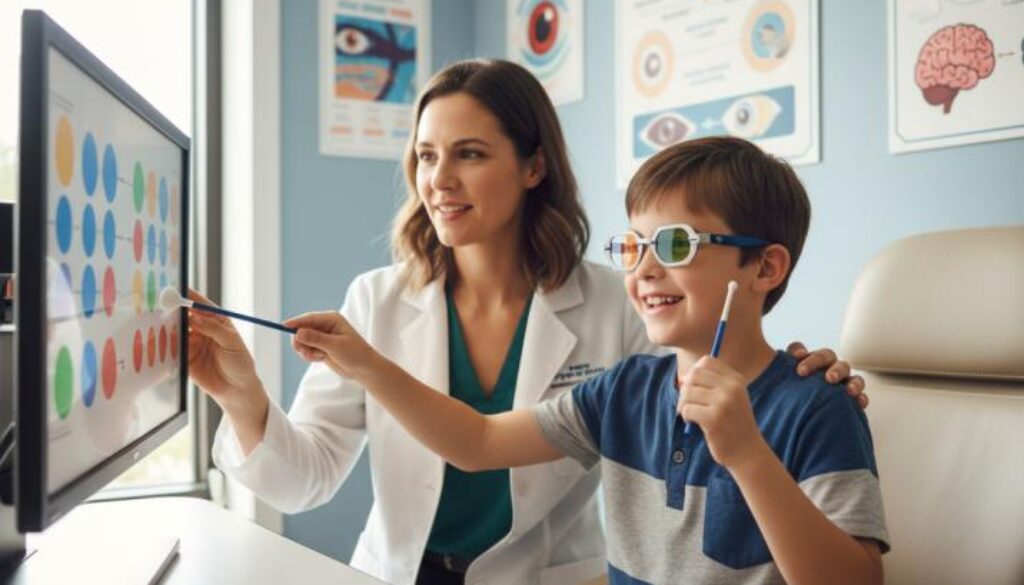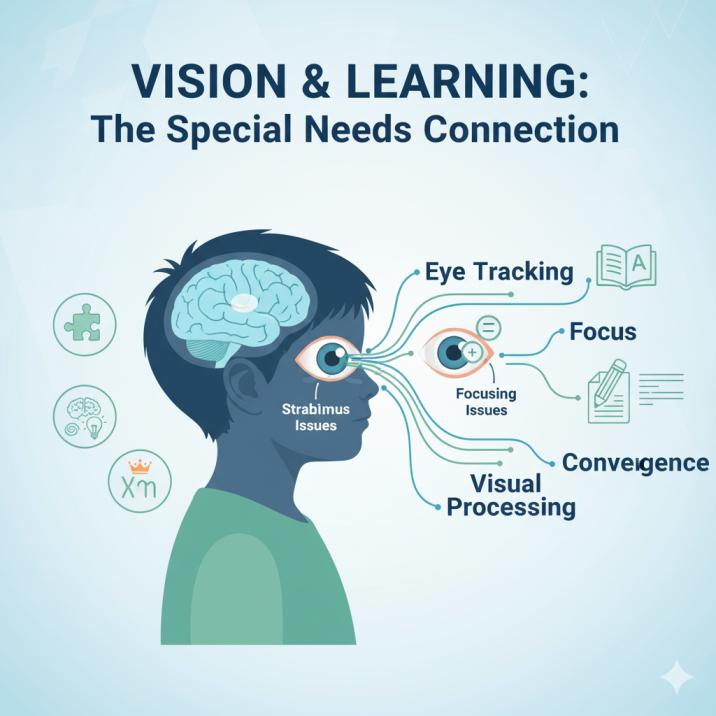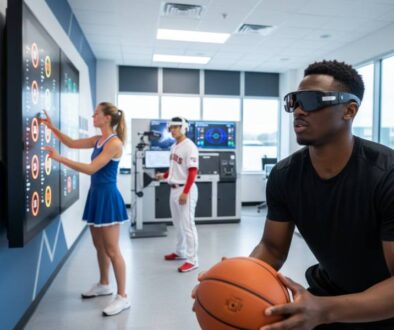Vision Therapy for Special Needs Children

Executive Summary
Children with special needs experience vision problems at significantly higher rates than the general population, with up to 80% of sensory information processed through the visual system involving 35 brain areas. While 25% of all children struggle with reading and learning difficulties due to undiagnosed vision conditions, research shows an even higher percentage of special needs children face undetected vision problems.
Developmental vision therapy offers a specialized, evidence-based approach to address these challenges through customized treatment programs that improve visual skills and enhance overall quality of life. This comprehensive guide explores how eye therapy for special needs children can transform learning outcomes and developmental progress.
Understanding Vision Challenges in Special Needs Children
The Hidden Connection Between Vision and Learning
Among special education populations, children can be categorized into four main groups: developmental conditions (Down syndrome, autism, dyslexia), behavioral/emotional conditions (ADHD, mental health disorders), physical conditions (muscular dystrophy, multiple sclerosis), and sensory impairments. Current federal data shows that 15% of all public school students ages 3 to 21 receive special education services, representing 7.5 million students in the most recent school year.
What many parents don’t realize is that vision problems often masquerade as behavioral or learning issues. Many behaviors perceived as part of a special needs diagnosis may actually stem from underlying vision problems that remain undetected. Children might appear inattentive, struggle with reading, or exhibit behavioral challenges when the root cause is a treatable vision condition.
Prevalence of Vision Problems in Special Needs Populations
Recent research reveals concerning statistics about vision problems in special needs children:
- According to the CDC’s April 2025 data, autism spectrum disorder now affects 1 in 31 children in the United States, representing a significant increase from previous estimates
- Children with autism spectrum disorder show definitive associations with multiple vision conditions, according to a 2023 meta-analysis of 49 studies involving over 15 million individuals.
- The prevalence of vision problems is 15.6% in children with ADHD, compared to 8.3% in typical children.
- Over 60% of children with Down syndrome experience vision problems, with refractive errors being the most common (70% prevalence)
Common Vision Conditions in Special Needs Children
Vision disorders affecting special needs children include nearsightedness, farsightedness, strabismus (eye turns), amblyopia (lazy eye), and eye movement dysfunction, which can cause distorted visual perception and depth perception problems.
Specific conditions include:
Refractive Errors: Nearsightedness, farsightedness, and astigmatism occur at higher rates in special needs populations.
Binocular Vision Disorders: Problems with eye coordination and teamwork affect how children process three-dimensional information.
Eye Movement Disorders: Difficulties with tracking, focusing, and visual processing that impact reading and learning.
Visual Processing Issues: Challenges in interpreting and understanding visual information, even when eyesight appears normal.
What Is Developmental Vision Therapy?
Defining the Science
Developmental vision therapy is a customized treatment program designed to improve and strengthen visual skills while retraining the visual system to interpret input with increased accuracy and ease. This approach goes beyond simple eye exercises to improve brain-eye communication and enhance visual skills, including eye-tracking, focusing, convergence, and visual processing speed.
The Neuroplasticity Foundation
Developmental vision therapy utilizes neuroplasticity – the brain’s ability to reorganize by forming new neural connections. Recent neurology research demonstrates that neuroplasticity occurs not only in early childhood but continues throughout life, allowing the brain to change structure and function in response to therapy.
Evidence-Based Approach
Boston Children’s Hospital is one of the few pediatric hospitals in the country offering vision therapy, with its ophthalmologist-in-chief noting that while many professionals remain skeptical, emerging evidence supports its effectiveness for specific conditions.
How Vision Therapy Works for Special Needs Children
Comprehensive Assessment Process
A comprehensive assessment typically requires a developmental vision evaluation to examine the integrity of visual skills. The evaluation process includes reviewing family medical history, medications, and relevant factors that may impact visual development.
Evaluation components include:
Visual Acuity Testing: Measuring how clearly each eye sees at various distances.
Binocular Vision Assessment: Evaluating how well the eyes work together as a team.
Eye Movement Analysis: Testing tracking, focusing, and coordination abilities.
Visual Processing Evaluation: Assessing how the brain interprets visual information.
Customized Treatment Programs
Each vision therapy program is fully customized and individualized, using specialized lenses, filters, prisms, and instruments as part of the training regimen. Treatment plans focus on the child’s specific needs and visual problems, with exercises and tasks that change based on progress.
Treatment Modalities
In-Office Sessions: Supervised exercises using specialized equipment and techniques.
Home-Based Activities: Complementary exercises designed to reinforce in-office training.
Computer-Based Programs: Advanced technologies and computer-based therapies have transformed traditional exercises into fun, interactive activities.
Adaptive Equipment: Specialized tools including prisms, filters, and visual training devices.
Conditions Successfully Treated
Autism Spectrum Disorders
A 2024 case report demonstrated significant improvements in eye movements for a child with autism spectrum disorder and Down syndrome following vision therapy intervention. Treatment breakthrough studies in 2024 showed measurable improvements in autism-related behaviors following targeted vision therapy interventions.
Benefits for children with autism include:
- Improved eye contact and social interaction
- Enhanced visual attention and focus
- Better environmental awareness
- Reduced behavioral challenges related to visual processing
ADHD and Attention Disorders
The prevalence of ADHD in children with convergence insufficiency is approximately three times higher than in the general population. Vision therapy can help improve attention, visual processing, and visual-motor integration skills, leading to better academic performance and overall quality of life for children with ADHD.
ADHD-related improvements include:
- Enhanced sustained attention during reading tasks
- Improved focus and concentration abilities
- Better classroom performance
- Reduced eye strain and fatigue
Down Syndrome
Down syndrome affects approximately 1 in 700 to 1,000 births and is the most common genetic developmental disorder. Children with Down syndrome require custom-fit eyeglasses due to unique facial features, with specialized frame adjustments for proper fit. Recent 2025 research shows that refractive errors affect 70% of people with Down syndrome, making it the most common vision condition, followed by strabismus (31.1%), lens opacities (13.8%), and nystagmus (12.7%). Vision therapy as early intervention shows promise for children with Down syndrome, particularly when combined with other developmental approaches.
Learning Disabilities and Dyslexia
Multiple studies demonstrate connections between vision problems and learning disabilities, with vision therapy showing effectiveness in improving reading performance. Success stories include children moving from struggling readers to top performers following comprehensive vision therapy programs.
Scientific Evidence & Research
Meta-Analysis Findings
A landmark 2023 systematic review published in Molecular Psychiatry analyzed 49 studies encompassing over 15 million individuals worldwide, finding definitive associations between autism spectrum disorder and multiple vision conditions.
Population Studies
Taiwanese researchers in 2024 examined 20,688 children with autism spectrum disorder alongside over 2 million matched controls, confirming elevated rates of hyperopia, myopia, astigmatism, and strabismus across the autism spectrum.
Treatment Effectiveness Research
Research demonstrates that vision therapy is an evidence-based treatment with clinical trials showing effectiveness in improving visual skills needed for clear, comfortable vision. While randomized controlled trials remain limited, emerging studies support vision therapy’s effectiveness for specific conditions.
The Treatment Process: What Parents Can Expect
Initial Consultation
The journey begins with a comprehensive developmental vision evaluation. The doctor will review family medical history, current medications, and relevant factors that may impact visual development.
Treatment Planning
Intervention planning meets the defined needs of each child rather than exceeding them, starting with what the child can do and gradually introducing new elements based on their learning pace.
Program Duration and Expectations
Improved visual skills are often noticed after a few weeks, though each patient differs, with treatment ranging from weeks to six months, depending on the specific therapy regimen. Some gains are typically seen fairly soon, but significant results may take up to six months, depending on the patient and their specific therapy regimen.
Monitoring Progress
Regular progress reviews with the child and parents help keep everyone informed and motivated, ensuring therapy remains aligned with the child’s evolving needs and interests.
Creating Engaging Therapy Experiences
Making Therapy Fun and Effective
All vision therapy activities should be conducted through play in a fun way because children learn best through play. Activities are designed to meet developmental needs and motivation while being optimally challenging to create a sense of achievement.
Gamification Approaches
Modern vision therapy incorporates game-based elements to maintain engagement:
Interactive Computer Programs: Technology-based exercises that feel like video games rather than medical treatment.
Achievement Systems: Progress tracking that celebrates milestones and improvements.
Reward Structures: Positive reinforcement systems that motivate continued participation.
Social Elements: Group activities or family involvement that make therapy a shared experience.
Family Involvement
Parents need to understand all steps involved and why they are being taken, with professionals providing support to ensure children don’t give up. Successful outcomes depend on active engagement from the prescribing doctor, patient, and parents working together.
Addressing Common Concerns and Questions
Safety and Effectiveness
While some professional organizations express caution about vision therapy for learning disabilities, there is sufficient evidence supporting its use for specific conditions like convergence insufficiency. All patients seeking vision therapy should be evaluated by a pediatric ophthalmologist for a second opinion.
Cost and Insurance Considerations
Vision therapy is often not covered by insurance programs, making cost an important consideration for families. Comprehensive vision evaluations typically range from several hundred to over $1,000, while complete treatment programs can range from $2,000 to $8,000 or more, depending on the duration and complexity of the individual program. However, many families find the long-term benefits justify the investment in their child’s development. It’s important to check with individual providers for current pricing in your area, as costs vary significantly by region and provider.
Alternative Approaches
Some research suggests home-based approaches can be effective, with one randomized controlled trial using home-based video games showing improvements in certain types of amblyopia.
Real-World Success Stories
Academic Improvements
Case examples include children like Evan, who had double vision and headaches while reading, but completed therapy and reached the top of his class in reading performance. Walker showed significant improvements after struggling with reading difficulties, including skipping lines and reading avoidance, but gained confidence and speed following therapy.
Behavioral Changes
Parents report transformational changes: “8 weeks of vision therapy has done more than all 3 years of tutoring,” with children gaining confidence and enthusiasm for reading and learning.
Quality of Life Enhancement
Vision therapy enables children with special needs to understand their surroundings with greater certainty, consequently improving behaviors such as anxiety management, social skills, and verbal communication.
Choosing the Right Provider
Qualifications to Look For
Vision therapy is a sub-specialty of optometry, with only 5-10% of optometrists providing these services. Optometrists specializing in vision therapy may call themselves pediatric optometrists, behavioral optometrists, or developmental optometrists.
Questions to Ask Potential Providers
When evaluating vision therapy providers, consider asking:
Experience with Special Needs: How many special needs children have they treated?
Customization Approach: How do they adapt therapy for different developmental levels?
Success Metrics: What criteria do they use to define successful treatment?
Program Duration: What is the expected timeframe for seeing results?
Cost Structure: What are the total costs, and are any covered by insurance?
Red Flags to Avoid
Be cautious of providers using potentially harmful techniques or making unrealistic promises about treating learning disabilities without proper evaluation.
Supporting Your Child Through the Process
Creating a Supportive Environment
Success requires ensuring children feel successful and don’t give up, with professionals knowing when and how to provide appropriate support.
Home Reinforcement Strategies
Consistent Practice: Maintaining regular home exercise schedules as prescribed.
Positive Reinforcement: Celebrating small victories and progress milestones.
Environmental Modifications: Adapting home and school environments to support visual development.
Communication: Maintaining open dialogue with therapists and school personnel.
School Collaboration
Parents should communicate with teachers and administrators to ensure they understand the child’s special visual needs and that appropriate accommodations are being made in the classroom.
The Future of Vision Therapy for Special Needs
Technological Advances
Eye tracking-based methods are being developed that don’t rely on verbal or manual responses, making them more applicable to the spectrum of abilities in individuals with visual impairments. AI-enabled image analysis is being used to evaluate whether children with suspected visual impairments gaze at similar image features.
Research Directions
Recent studies using eye tracking to identify ADHD in children show promising results, with eye movement analysis potentially improving diagnostic precision. Computer vision techniques are showing a strong impact on autism research, with applications in diagnosis and therapy.
Integration with Other Therapies
The future likely holds increased integration between vision therapy and other developmental interventions, creating comprehensive treatment approaches that address multiple aspects of special needs conditions simultaneously.
Taking Action: Next Steps for Parents
When to Seek Evaluation
Parents should watch for red flags, including omitting or skipping small words when reading, frequent headaches, eye strain, avoiding reading tasks, and difficulty with fine motor skills.
Preparing for Your Visit
Gather Documentation: Collect previous eye exam results, educational assessments, and medical records.
List Symptoms: Document specific challenges your child faces with reading, learning, or visual tasks.
Prepare Questions: Develop a list of concerns and questions about your child’s visual development.
Set Expectations: Understand that comprehensive evaluations may take several hours.
Building Your Support Team
Successful outcomes often require collaboration between:
Vision Therapy Specialists: Providing direct treatment and monitoring progress.
Educational Professionals: Adapting classroom environments and teaching strategies.
Other Healthcare Providers: Coordinating with pediatricians, occupational therapists, and other specialists.
Family Members: Creating consistent support across all environments.
Key Resources and Citations
The following resources provided essential data and research findings referenced throughout this article:
1. CDC Autism and Developmental Disabilities Monitoring Network (2025)
Source: Centers for Disease Control and Prevention Link: https://www.cdc.gov/mmwr/volumes/74/ss/ss7402a1.htm
Key Contribution: This landmark April 2025 report provided the updated autism prevalence data showing 1 in 31 children are now diagnosed with autism spectrum disorder, representing the most current national statistics available.
2. Association Between Autism Spectrum Disorder and Vision Problems: Systematic Review and Meta-Analysis
Source: Molecular Psychiatry, 2023 Link: https://www.nature.com/articles/s41380-023-02143-7
Key Contribution: This comprehensive meta-analysis of 49 studies involving over 15 million individuals worldwide provided definitive evidence of associations between autism spectrum disorders and multiple vision conditions, forming a cornerstone of the autism-vision connection discussed in the article.
3. The Ocular Manifestations of Down Syndrome: Systematic Review and Meta-Analysis
Source: Journal of Ophthalmology, 2025
Link: https://onlinelibrary.wiley.com/doi/10.1155/joph/2317959
Key Contribution: This recent systematic review provided the updated prevalence statistics for vision problems in Down syndrome, including the 70% prevalence of refractive errors and 31.1% prevalence of strabismus cited in the article.
Conclusion: Transforming Lives Through Vision
For children with special needs, undiagnosed vision problems can create unnecessary barriers to learning, social interaction, and overall development. However, with identification and resolution of underlying vision problems, these children can achieve what their families may have thought would never be possible.
Developmental vision therapy represents a scientifically-grounded approach to addressing these challenges. By addressing specific visual impairments through specialized exercises, vision therapy enhances both academic and developmental progress while boosting independence and self-confidence.
Parents and educators should consider vision therapy as part of a comprehensive educational plan for children with special needs. While not every child will require vision therapy, a comprehensive evaluation can identify those who would benefit from this life-changing intervention.
The journey may require patience, commitment, and resources, but the potential rewards – improved academic performance, enhanced quality of life, and increased independence – make vision therapy a valuable consideration for any family navigating the complex world of special needs care.
Take the first step today: Schedule a comprehensive developmental vision evaluation with a qualified provider to discover whether vision therapy could help unlock your child’s full potential.
Contact Cook Vision Therapy Center:
- Phone: (770) 419-0400
- Location
- Website: https://www.cookvisiontherapy.com/
- Serving: Metro Atlanta, including Marietta, Duluth, Roswell, Sandy Springs, Woodstock, Kennesaw, and surrounding areas.
Remember: Vision therapy isn’t just about improving eyesight – it’s about transforming lives, enhancing learning, and helping children with special needs reach their full potential.
FAQs
-
Vision therapy strengthens eye-brain coordination and visual processing skills through personalized exercises. It improves eye tracking, focus, depth perception, and hand-eye coordination, helping children better understand their environment and reducing anxiety or behavioral challenges.




